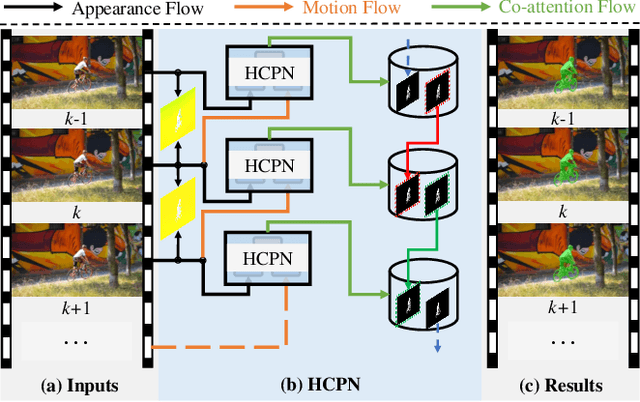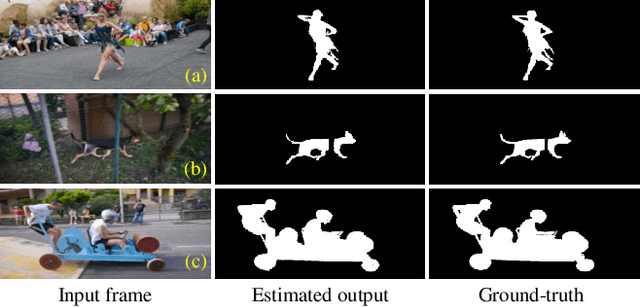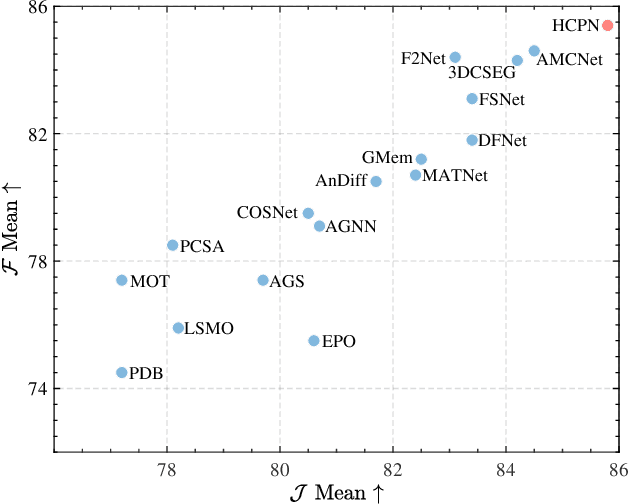Gensheng Pei
Knowledge Transfer with Simulated Inter-Image Erasing for Weakly Supervised Semantic Segmentation
Jul 03, 2024Abstract:Though adversarial erasing has prevailed in weakly supervised semantic segmentation to help activate integral object regions, existing approaches still suffer from the dilemma of under-activation and over-expansion due to the difficulty in determining when to stop erasing. In this paper, we propose a \textbf{K}nowledge \textbf{T}ransfer with \textbf{S}imulated Inter-Image \textbf{E}rasing (KTSE) approach for weakly supervised semantic segmentation to alleviate the above problem. In contrast to existing erasing-based methods that remove the discriminative part for more object discovery, we propose a simulated inter-image erasing scenario to weaken the original activation by introducing extra object information. Then, object knowledge is transferred from the anchor image to the consequent less activated localization map to strengthen network localization ability. Considering the adopted bidirectional alignment will also weaken the anchor image activation if appropriate constraints are missing, we propose a self-supervised regularization module to maintain the reliable activation in discriminative regions and improve the inter-class object boundary recognition for complex images with multiple categories of objects. In addition, we resort to intra-image erasing and propose a multi-granularity alignment module to gently enlarge the object activation to boost the object knowledge transfer. Extensive experiments and ablation studies on PASCAL VOC 2012 and COCO datasets demonstrate the superiority of our proposed approach. Source codes and models are available at https://github.com/NUST-Machine-Intelligence-Laboratory/KTSE.
Relating CNN-Transformer Fusion Network for Change Detection
Jul 03, 2024



Abstract:While deep learning, particularly convolutional neural networks (CNNs), has revolutionized remote sensing (RS) change detection (CD), existing approaches often miss crucial features due to neglecting global context and incomplete change learning. Additionally, transformer networks struggle with low-level details. RCTNet addresses these limitations by introducing \textbf{(1)} an early fusion backbone to exploit both spatial and temporal features early on, \textbf{(2)} a Cross-Stage Aggregation (CSA) module for enhanced temporal representation, \textbf{(3)} a Multi-Scale Feature Fusion (MSF) module for enriched feature extraction in the decoder, and \textbf{(4)} an Efficient Self-deciphering Attention (ESA) module utilizing transformers to capture global information and fine-grained details for accurate change detection. Extensive experiments demonstrate RCTNet's clear superiority over traditional RS image CD methods, showing significant improvement and an optimal balance between accuracy and computational cost.
A Light-weight Transformer-based Self-supervised Matching Network for Heterogeneous Images
Apr 30, 2024



Abstract:Matching visible and near-infrared (NIR) images remains a significant challenge in remote sensing image fusion. The nonlinear radiometric differences between heterogeneous remote sensing images make the image matching task even more difficult. Deep learning has gained substantial attention in computer vision tasks in recent years. However, many methods rely on supervised learning and necessitate large amounts of annotated data. Nevertheless, annotated data is frequently limited in the field of remote sensing image matching. To address this challenge, this paper proposes a novel keypoint descriptor approach that obtains robust feature descriptors via a self-supervised matching network. A light-weight transformer network, termed as LTFormer, is designed to generate deep-level feature descriptors. Furthermore, we implement an innovative triplet loss function, LT Loss, to enhance the matching performance further. Our approach outperforms conventional hand-crafted local feature descriptors and proves equally competitive compared to state-of-the-art deep learning-based methods, even amidst the shortage of annotated data.
Dynamic in Static: Hybrid Visual Correspondence for Self-Supervised Video Object Segmentation
Apr 21, 2024Abstract:Conventional video object segmentation (VOS) methods usually necessitate a substantial volume of pixel-level annotated video data for fully supervised learning. In this paper, we present HVC, a \textbf{h}ybrid static-dynamic \textbf{v}isual \textbf{c}orrespondence framework for self-supervised VOS. HVC extracts pseudo-dynamic signals from static images, enabling an efficient and scalable VOS model. Our approach utilizes a minimalist fully-convolutional architecture to capture static-dynamic visual correspondence in image-cropped views. To achieve this objective, we present a unified self-supervised approach to learn visual representations of static-dynamic feature similarity. Firstly, we establish static correspondence by utilizing a priori coordinate information between cropped views to guide the formation of consistent static feature representations. Subsequently, we devise a concise convolutional layer to capture the forward / backward pseudo-dynamic signals between two views, serving as cues for dynamic representations. Finally, we propose a hybrid visual correspondence loss to learn joint static and dynamic consistency representations. Our approach, without bells and whistles, necessitates only one training session using static image data, significantly reducing memory consumption ($\sim$16GB) and training time ($\sim$\textbf{2h}). Moreover, HVC achieves state-of-the-art performance in several self-supervised VOS benchmarks and additional video label propagation tasks.
VideoMAC: Video Masked Autoencoders Meet ConvNets
Feb 29, 2024Abstract:Recently, the advancement of self-supervised learning techniques, like masked autoencoders (MAE), has greatly influenced visual representation learning for images and videos. Nevertheless, it is worth noting that the predominant approaches in existing masked image / video modeling rely excessively on resource-intensive vision transformers (ViTs) as the feature encoder. In this paper, we propose a new approach termed as \textbf{VideoMAC}, which combines video masked autoencoders with resource-friendly ConvNets. Specifically, VideoMAC employs symmetric masking on randomly sampled pairs of video frames. To prevent the issue of mask pattern dissipation, we utilize ConvNets which are implemented with sparse convolutional operators as encoders. Simultaneously, we present a simple yet effective masked video modeling (MVM) approach, a dual encoder architecture comprising an online encoder and an exponential moving average target encoder, aimed to facilitate inter-frame reconstruction consistency in videos. Additionally, we demonstrate that VideoMAC, empowering classical (ResNet) / modern (ConvNeXt) convolutional encoders to harness the benefits of MVM, outperforms ViT-based approaches on downstream tasks, including video object segmentation (+\textbf{5.2\%} / \textbf{6.4\%} $\mathcal{J}\&\mathcal{F}$), body part propagation (+\textbf{6.3\%} / \textbf{3.1\%} mIoU), and human pose tracking (+\textbf{10.2\%} / \textbf{11.1\%} PCK@0.1).
Hierarchical Graph Pattern Understanding for Zero-Shot VOS
Dec 15, 2023



Abstract:The optical flow guidance strategy is ideal for obtaining motion information of objects in the video. It is widely utilized in video segmentation tasks. However, existing optical flow-based methods have a significant dependency on optical flow, which results in poor performance when the optical flow estimation fails for a particular scene. The temporal consistency provided by the optical flow could be effectively supplemented by modeling in a structural form. This paper proposes a new hierarchical graph neural network (GNN) architecture, dubbed hierarchical graph pattern understanding (HGPU), for zero-shot video object segmentation (ZS-VOS). Inspired by the strong ability of GNNs in capturing structural relations, HGPU innovatively leverages motion cues (\ie, optical flow) to enhance the high-order representations from the neighbors of target frames. Specifically, a hierarchical graph pattern encoder with message aggregation is introduced to acquire different levels of motion and appearance features in a sequential manner. Furthermore, a decoder is designed for hierarchically parsing and understanding the transformed multi-modal contexts to achieve more accurate and robust results. HGPU achieves state-of-the-art performance on four publicly available benchmarks (DAVIS-16, YouTube-Objects, Long-Videos and DAVIS-17). Code and pre-trained model can be found at \url{https://github.com/NUST-Machine-Intelligence-Laboratory/HGPU}.
* accepted by IEEE Transactions on Image Processing
Co-attention Propagation Network for Zero-Shot Video Object Segmentation
Apr 08, 2023



Abstract:Zero-shot video object segmentation (ZS-VOS) aims to segment foreground objects in a video sequence without prior knowledge of these objects. However, existing ZS-VOS methods often struggle to distinguish between foreground and background or to keep track of the foreground in complex scenarios. The common practice of introducing motion information, such as optical flow, can lead to overreliance on optical flow estimation. To address these challenges, we propose an encoder-decoder-based hierarchical co-attention propagation network (HCPN) capable of tracking and segmenting objects. Specifically, our model is built upon multiple collaborative evolutions of the parallel co-attention module (PCM) and the cross co-attention module (CCM). PCM captures common foreground regions among adjacent appearance and motion features, while CCM further exploits and fuses cross-modal motion features returned by PCM. Our method is progressively trained to achieve hierarchical spatio-temporal feature propagation across the entire video. Experimental results demonstrate that our HCPN outperforms all previous methods on public benchmarks, showcasing its effectiveness for ZS-VOS.
Hierarchical Feature Alignment Network for Unsupervised Video Object Segmentation
Jul 19, 2022



Abstract:Optical flow is an easily conceived and precious cue for advancing unsupervised video object segmentation (UVOS). Most of the previous methods directly extract and fuse the motion and appearance features for segmenting target objects in the UVOS setting. However, optical flow is intrinsically an instantaneous velocity of all pixels among consecutive frames, thus making the motion features not aligned well with the primary objects among the corresponding frames. To solve the above challenge, we propose a concise, practical, and efficient architecture for appearance and motion feature alignment, dubbed hierarchical feature alignment network (HFAN). Specifically, the key merits in HFAN are the sequential Feature AlignMent (FAM) module and the Feature AdaptaTion (FAT) module, which are leveraged for processing the appearance and motion features hierarchically. FAM is capable of aligning both appearance and motion features with the primary object semantic representations, respectively. Further, FAT is explicitly designed for the adaptive fusion of appearance and motion features to achieve a desirable trade-off between cross-modal features. Extensive experiments demonstrate the effectiveness of the proposed HFAN, which reaches a new state-of-the-art performance on DAVIS-16, achieving 88.7 $\mathcal{J}\&\mathcal{F}$ Mean, i.e., a relative improvement of 3.5% over the best published result.
 Add to Chrome
Add to Chrome Add to Firefox
Add to Firefox Add to Edge
Add to Edge